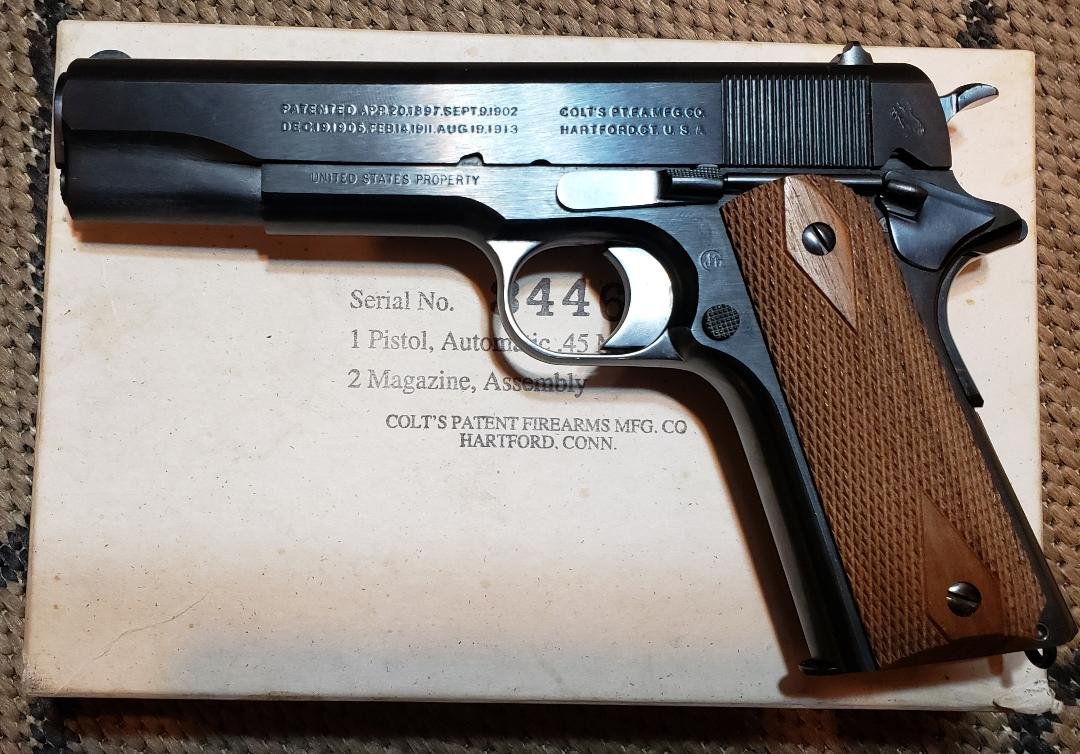Wwi Colt 1911 - Well, original WW1-era Colt 1911s are rare and expensive these days. That's why in late 2003 Colt Custom Shop released a limited production copy of the M1911 pistol based on the original 1911 designs. These pistols are faithful reproductions of the 1911 Colt Government used by the United States Army in World War I.
It should be noted that between 2003 and 2009 Colt produced two copies of the "Model 1911" in the .45 ACP, but the difference is only in the finish; "Carbonia Blue" - reminiscent of the deep ornament seen on the Colts civilian market and at early military parties, followed by a second series called the "1918 Model" with a "Black Oxide" coating similar to that used for Colt's later war weapons. (around 1918) when production processes were simplified. The pistol tested here belongs to this second series production.
Wwi Colt 1911

The Colt 1911 WW1 "Model 1918" replica features a "Black Oxide" finish similar to that used on later wartime rifles.
Colt Wwi Commemorative 1911 Pistol 4832 Ct
The presentation of the gun highlights the "limited" nature of this production, a beautiful rectangular box made of blue cardboard with the gold-coloured Colt logo. Inside the box are two compartments for accessories and gun. The latter is contained in a cardboard box that reproduces the military packaging used to ship military Colt 1911s from the factory. Two seven-round magazines are provided. unfortunately they are all blue and not 'dual toned' like the originals. Accessories include a cable lock, a standard orange plastic cabinet safety flag, and an L-shaped tool that's a beautiful replica of the original removal tool. Finally, there is a copy of the 1912 User's Manual (1914 Revised Edition).
Underneath the "Belle Epoque" suit is basically a 70 Series Colt mechanic, meaning it lacks the trigger safety and has a few 80 Series elements (like an extractor hood). However, this in no way diminishes Colt's outstanding reverse engineering effort to reproduce the original 1911 specifications as closely as possible.
Ordnance Inspector Major John M. Gilbert's reproduced seal of approval is clear and real in appearance.
To summarize the external differences between the original WW1 Colt 1911 and the 1911A1 version introduced in 1924; blade front sight, longer hammer and checkerboard grips with "Double Diamond" embossed. All these details, also Major John M. Gilbert Seal of Approval, August 10, 1917 - March 29, 1918.
Colt 1911 Wwi Commemorative Set .45acp Royal Blue*amazing Wwi History*
Like the original WW1 Colts, this replica features a shorter grip safety handle, blade front and longer hammer.
The clear "United State PROPERTY" mark on the left side of the bezel and the vintage-style Colt mark on the back of the sled really warm the hearts of collectors. The bezel ring is also a nice touch.
In addition, the barrel has the correct feed ramp profile, very similar to the profile of the original military pistols. Another nice touch is the sliding window in the completely uncut frame like a modern 1911. You have to pull out the gun to notice it, but it's there.

The slide and frame fit very well with no play even when swinging the rifle, which is always good news. Here the material is completely steel. there is no aluminum, plastic or polymer anywhere, and the barrel length is of course the traditional 5.
Colt Wwi Commemorative 1911 Pistol 4832 Bw
Two types of round-nosed commercial ammunition, 230-grain and 226-grain, were used in the firing test. We actually wanted to be consistent with the ammunition used by the military.
Two .45 ACP 226 lead round-nosed rounds were captured after the test firing. Note the marks left by the barrel rifle.
The tested pistol tended to fire from about 5 inches low at 25 yards. The offense should be placed on fixed sights, especially on the light-reflecting front sight in almost all cases, with its semicircular and glossy finish. Anyway, with a little practice you can get very satisfactory results in terms of accuracy. after a few clips you really have to do your best to miss the black target.
Making this copy also made us understand why they decided on a longer grip safety trigger with the 1911A1; With the Model 1911, some annoying "hammer bites" in the hand web are almost inevitable if you don't get a proper grip. .
Colt 1911 Ww1 Repo Version Gun
A great classic field strip. Primarily the 70 Series Colt mechanics and some 80 Series elements (like the extractor).
Unfortunately, the Colt 1911 WW1 replica was produced in limited numbers and is no longer in production. But if you find one for sale, why should you buy it? It is not a personal defense weapon as the lack of range security is unacceptable these days. It's not even a target weapon. While we're sure better shooters than we can get interesting results with it, the military Colt-Browning system pistol with its early 20th century teenage sights isn't the best choice for a crossbow.
Like this. Even if it's a replica, it's a collector's item in itself. That typical item you might appreciate for completely illogical reasons: the charm of good times. And we think that's more than enough.
Here we'll tell you why the 1911 remains one of the most respected pistols for self-defense and professional use.
Colt 1911 Wwi Reproduction Carbonia Blue Nib
Here you will find a comparison between the SIG Sauer Match Elite and the original Colt Government M 1911. The M1911 (Colt 1911 or Colt Governmt) is a single-action, blowback, semi-automatic pistol chambered for the .45 ACP cartridge. .
As of 1940, the official US military designation of the pistol was Automatic Pistol, Caliber .45, M1911 for the original model adopted in March 1911, and Automatic Pistol, Caliber .45, M1911A1 for the improved M1911A1 model that changed the design. Vietnam War era Pistol, Caliber .45, Automatic to M1911A1.
Designed by John Browning, the M1911 is the most famous of his designs, as it uses the short recoil principle in its basic design. The gun was widely copied, and this operating system formed the basis of the 20th century and almost all modern firearms. It is popular with civilian shooters in competitive matches such as the International Defensive Pistol Association and the International Practical Shooting Confederation.
The US military purchased approximately 2.7 million M1911 and M1911A1 pistols during service. The pistol served as the standard weapon for the United States Armed Forces from 1911 to 1985. It was widely used in the First World War, the Second World War, the Korean War and the Vietnam War. The M1911A1 was replaced in 1985 with the adoption of the 9mm Beretta M9 pistol as the standard US military weapon. However, the US Army replaced the M1911A1 with the Beretta M9 in October 1986 and due to the popularity of the M1911 among its users; not completely removed. Upgraded variants of the M1911 are still used by the US Army Special Forces, US Marine Corps and some units of the US Navy.
Colt 1911 Black Army Wwi (1917) .45acp
The M1911 pistol emerged in the late 1890s as a result of the search for a suitable self-loading (or semi-automatic) pistol to replace the various pistols in use.
The United States was adopting new firearms at an extraordinary rate. A number of Colt and Smith & Wesson pistols were adopted for the Army and Navy in the same decade, with several new pistols and two completely new service rifles (M1892/96/98 Krag and M1895 Navy Lee). The following decade would see a similar pace, including the adoption of a few more pistols and intense research for a self-loading pistol, resulting in the official adoption of the M1911 by the end of the decade.
Hiram S. Maxim had designed a self-loading rifle in the 1880s, but was preoccupied with machine guns. However, the application of the principle of harnessing the energy of bullets gave rise to several self-loading pistols in 1896. The projects attracted the attention of various armies, each of whom began to find programs suitable for their own forces. In the US, such a program would lead to official testing in the late 20th century.

In late 1899 and early 1900, self-loading pistols were tested, including Mauser (C96 "Broomhandle"), Mannlicher (Mannlicher M1894), and Colt (Colt M1900).
Exceptional Pair Of Colt 1911 Pistols With Matching Serial Numbers Commemorating Wwi Battles. One
This resulted in the purchase of 1,000 DWM Luger pistols chambered in 7.65mm Luger, a bottled cartridge.
Colt commander 1911 holster, zahar toys colt 1911, colt government 1911 holster, colt 45 1911 holster, 1911 colt, colt wwi, colt 1911 wwi replica, wwi 1911, colt 1911 leather holster, blackhawk colt 1911 holster, colt 1911 iwb holster, colt 1911 toy


0 Comments